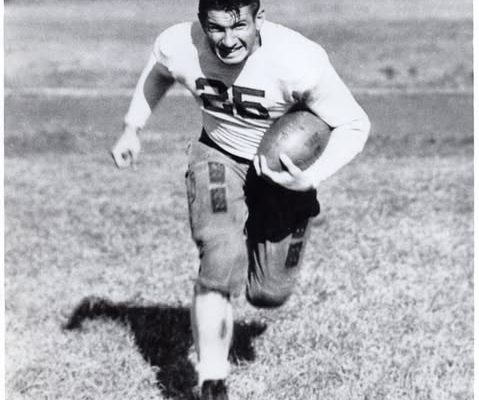John Cain’s story is one that embodies the grit, determination, and unmatched versatility of early Alabama football legends. Born in Montgomery, Alabama, Cain grew up in a time when football was a tougher, more grueling game, played without the modern luxuries of specialized positions or advanced protective gear. The era required players to be both physically and mentally tough, and Cain was a perfect fit for that mold. From the moment he stepped onto the field for the Crimson Tide, he demonstrated an ability to excel in multiple roles that few athletes could match, making him one of the most well-rounded and impactful players in the history of the program. Playing under the legendary Coach Wallace Wade from 1930 to 1932, Cain left his mark not just as a single-position star but as a true ironman who could dominate at quarterback, fullback, punter, and linebacker with equal skill and determination.
Cain’s arrival at Alabama coincided with one of the program’s most pivotal periods, a time when the Crimson Tide was emerging as a national powerhouse. In 1930, his sophomore year, Alabama put together a season that would set the standard for excellence in the years to come. That season’s team, disciplined and methodical under Wade’s guidance, was an unstoppable force, going undefeated and earning a berth in the Rose Bowl—a game that, in that era, served as the ultimate stage for college football greatness. Cain was at the heart of that team’s success, playing multiple roles to perfection. Whether delivering punishing runs from the fullback position, guiding the offense as quarterback, dropping back for booming punts to flip field position, or locking down opponents as a hard-hitting linebacker, Cain was the embodiment of a complete football player. His efforts that season helped Alabama secure the National Championship, a title that put the Tide firmly on the national map and cemented their place as one of the premier programs in college football.
The Rose Bowl victory that capped the 1930 season was more than just another win—it was a statement. Alabama’s victory over Washington State on New Year’s Day in 1931 was seen as a validation of Southern football’s legitimacy on the national stage. Cain’s contributions to that triumph were significant, not just in tangible plays but in the way he set the tone with his toughness and versatility. His performance that year earned him Second-Team All-American honors, a recognition that reflected his impact on the game despite competing in an era when players rarely received widespread media attention.
Cain’s 1931 season was arguably his finest. Now an established leader for the Crimson Tide, he continued to excel in multiple facets of the game, showcasing a football IQ and adaptability that made him a nightmare for opposing teams. That year, his efforts earned him First-Team All-American honors, placing him among the most celebrated players in the nation. In a time when the All-America designation was reserved for the most dominant and complete athletes, Cain’s inclusion was a testament to his rare skill set and relentless work ethic. He was not just a player who could fill in at different positions—he was elite at each one, a player who could take over a game on offense, defense, and special teams.
In his senior season of 1932, Cain once again played a critical role in Alabama’s success. While the team did not repeat its undefeated run from two years earlier, Cain’s leadership and consistency kept the Crimson Tide competitive at the highest level. His ability to read the field, deliver in clutch moments, and perform at a high level no matter the assignment earned him another selection as a Second-Team All-American. By the time his collegiate career ended, Cain had built a résumé that placed him among the all-time greats of Alabama football, even in an era rich with iconic names.
After his playing days in Tuscaloosa came to a close, Cain transitioned naturally into coaching, where his knowledge of the game and his leadership qualities proved just as valuable as his on-field abilities. In 1937, he became the head football coach at Southwestern Louisiana Institute, now known as the University of Louisiana at Lafayette. There, he guided the program through several seasons, leading from 1937 to 1941 before stepping away during World War II. The war years brought a different kind of challenge for Cain, but he once again showcased his adaptability by serving as the school’s baseball coach from 1942 to 1944, ensuring that athletics remained an important part of student life even during uncertain times.
When the war ended, Cain returned to his post as head football coach for the 1946 season, continuing to mold young athletes with the same principles of toughness, discipline, and versatility that had defined his own career. The following year, he joined the coaching staff at Ole Miss as a backfield coach, a position that allowed him to specialize in developing offensive talent. His impact at Ole Miss went beyond football, as he would later serve as the school’s head tennis coach from 1957 to 1973—a remarkable 16-year run that further demonstrated his unmatched breadth of athletic knowledge and leadership ability.
Cain’s life and career were a testament to the idea that great athletes are defined not just by their own accomplishments, but by their ability to elevate those around them. Whether as a player or a coach, Cain had a way of inspiring his teammates and players to push beyond their limits, to embrace hard work and adaptability as keys to success. His induction into the College Football Hall of Fame in 1973 was a fitting recognition of his contributions to the sport. It was a moment that celebrated not just his playing days, but the entirety of a career spent giving back to the game in countless ways.
Sadly, John Cain’s life was cut short when he passed away from leukemia in 1977. Yet even in death, his legacy has endured, both at Alabama and across the broader landscape of college sports. His story is still told in Tuscaloosa as a reminder of what it means to be a true team player—someone willing and able to do whatever is needed to help the team succeed. In an age when specialization dominates the sport, Cain’s career serves as a reminder of a different time, when the best athletes were those who could do it all, and do it all well.
Cain’s versatility is perhaps the most defining feature of his career. It’s rare enough for a player to excel at quarterback or linebacker, but to be among the best in the nation at both, while also handling fullback duties and punting responsibilities, is almost unheard of in today’s game. This ability made him invaluable to Coach Wallace Wade, who relied on Cain’s skill set to keep Alabama competitive no matter the situation. His toughness allowed him to play both ways in an era when substitutions were limited, and his football intelligence made him an on-field extension of the coaching staff.
The respect Cain earned from his peers and opponents alike was rooted not just in his physical talent, but in the way he approached the game. He played with a relentless determination, never taking a play off and never shying away from the physical demands of the sport. His work ethic set the standard for his teammates, and his leadership—both vocal and by example—was instrumental in building the culture of excellence that would become synonymous with Alabama football.
Even today, decades after his last game, John Cain’s name still resonates with Crimson Tide fans who value the history of the program. His accomplishments remind younger generations that Alabama’s tradition of greatness wasn’t built overnight, but through the dedication of players like Cain who were willing to give their all in every facet of the game. His induction into the College Football Hall of Fame ensures that his contributions will not be forgotten, but it is the stories passed down through the years that truly keep his memory alive.
In the grand history of Alabama football, there are countless legends whose names are etched into the program’s lore. But John Cain stands apart as one of the most complete athletes to ever wear the crimson and white. His ability to dominate at multiple positions, his leadership on and off the field, and his lifelong commitment to athletics make him a figure worthy of the highest admiration. From Montgomery to Tuscaloosa to coaching sidelines across the South, Cain’s journey is one of remarkable talent, unwavering dedication, and a legacy that will forever be etched in the annals of college football history.



